Lata Mangeshkar’s Profound Musical Impact
Posted by: Adhika | Posted on: October 5th, 2012 | No Comments

Childhood
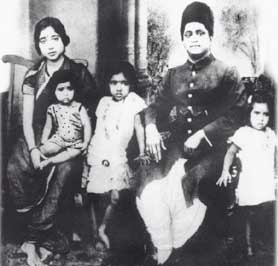 Lata Mangeshkar and family
Lata Mangeshkar and familyHer exposure to music began in infancy. Her father Deenanath was an accompanied classical vocalist and was very active in the theatre. It is said that Lata made her acting debut at the age of five in a play in which her father was participating.
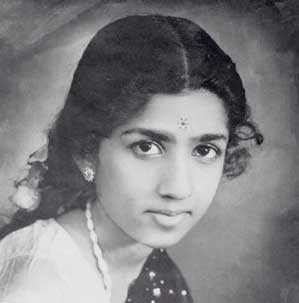
Lata’s musical studies were not limited to hearing her father sing. She also studied under Aman Ali Khan, and later under Amanat Khan, and acquired a good background in classical music.
Early Career
Lata’s early film career was characterized by numerous changes in direction, false starts, and a general unsteadiness. It was not at all clear that she was destined to be a successful singer. 1942 proved to be a very crucial year in her life. This was the year that the film “Kit Haaal” was release. This was the first film that Lata recorded for; unfortunately her song would be cut and not make it to the finished version. More traumatically for the young Lata, is that this was the year that her father died of a heart attack.
Lata was only 13 years old when her father died, but as the oldest child, responsibility fell upon her to help take care of her families financial needs. She took to acting in small films in order to do this. Her first appearance was a very small role in Pahili Mangalagaur (1942). Later she acted in such films as “Maajhe Baal” (1944), “Chimukla Sansar” (1943), “Gajabhau” (1944), “Jeevan Yatra” (1946), “Badi Maa” (1945).
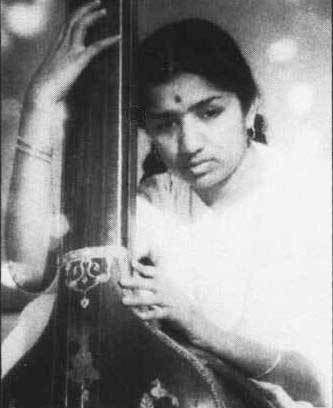 The period in the early 40’s did not look promising for Lata. Her thin voice was very different from the heavier voice quality that was in vogue (e.g., Noor Jahan). She received numerous rejections. It was not until 1947 that she was able to get a toehold in the industry by singing “Pa Lagoon Kar Jori Re” in the film “Aap ke Sewa Main” (1947). Lata sang several songs in other films over the next few years, but her first big hit was in 1949 with “Aayega Aanewaala”.
The period in the early 40’s did not look promising for Lata. Her thin voice was very different from the heavier voice quality that was in vogue (e.g., Noor Jahan). She received numerous rejections. It was not until 1947 that she was able to get a toehold in the industry by singing “Pa Lagoon Kar Jori Re” in the film “Aap ke Sewa Main” (1947). Lata sang several songs in other films over the next few years, but her first big hit was in 1949 with “Aayega Aanewaala”.There is no doubt that the partition played a role in Lata’s rise to fame. During the partition, there was a disruption when many directors, producers and artists left Bombay, while others migrated to India from Lahore. One of the most notable artists to leave India, was Noor Jahan, who was the undisputed queen of the filmsong at the time. This disruption opened the doors to Lata in an industry that previously may have been harder to get into.
As the 1950’s began, Lata was firmly established as a film singer. Music directors she sang for included such greats as Shankar-Jaikishan, and Anil Biswas. During this period, “Mahal”, “Barsaat”, “Ek Thi Ladki” and “Badi Bahen” were just some of the famous films that used her voice.
Lata’s Peak
The next three decades would see Lata Mangeshkar reign as the undisputed queen of the Hindi film song. She sang with almost all of the major music directors, and acquired a considerable clout in the politics of the film industry.
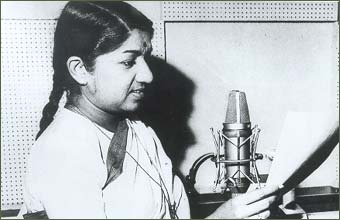 Lata Mangeshkar in recording session
Lata Mangeshkar in recording sessionIt is pointless to try and enumerate the songs that she did; however, there are a few songs which stand out. In particular “O Sajna Barkha Bahaar Aayee” from Parakh (1960), “Aaja re Pardesi” from Madhumati (1958), “Itna na Mujhse Tu Pyaar Badhaa” from Chhaya (1961), “Allah Tero Naam” from “Hum Dono” (1961), “Ehsaan Tera Hoga Mujh par” from “Junglee” (1961), and “Yeh Sama” from “Jab Jab Phool Khile” (1965), seem particularly notable. Subsequently in later decades her melodious voice captured us again and again in this classics: “Sun Sahiba Sun” (“Teri Ganga Maili” – 1986), “Yaara Seeli Seeli” (“Lekin” – 1990), even today stand our as some of her most memorable work. Lata also worked with most of the major music directors in this period. Her work with, both S.D. Burman and R.D Burman were very fruitful. She also worked with, Shankar /Jaikishan, Salil Chowdhury, Naushad and a host of others. It is often said that her best work came with her songs for Madan Mohan and C. Ramchandra. It is interesting to note that O.P. Nayyar was one of the few major music directors to not utilize her talents.
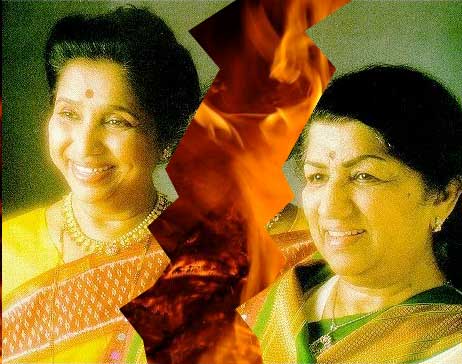 Relations between Lata and Asha
Relations between Lata and Asha
Lata’s Current Projects
In 2001 Lata Mangeshkar was awarded India’s highest civilian honor the “Bharat Ratna,” India’s highest civilian award presented on behalf of the Indian government. Lataji is now working on bringing to life the work of classical poets in a new rendition. She feels she has moved on from performing in mainstream Bollywood genre as she can not fully relate to the heroines of today and would like to focus on projects that resonate well with her. She is listed in the Guinness Book of World Records as the most recorded artist in the world. She has received three national awards and eight Filmfare awards after which she stopped accepting awards in order to promote new talent. She continues to sing every now and then for Hindi movies and perform live. Truly a living legend, Lata Mangeshkar has a talent that is second to none.

Facebook Comments
Leave a Comment